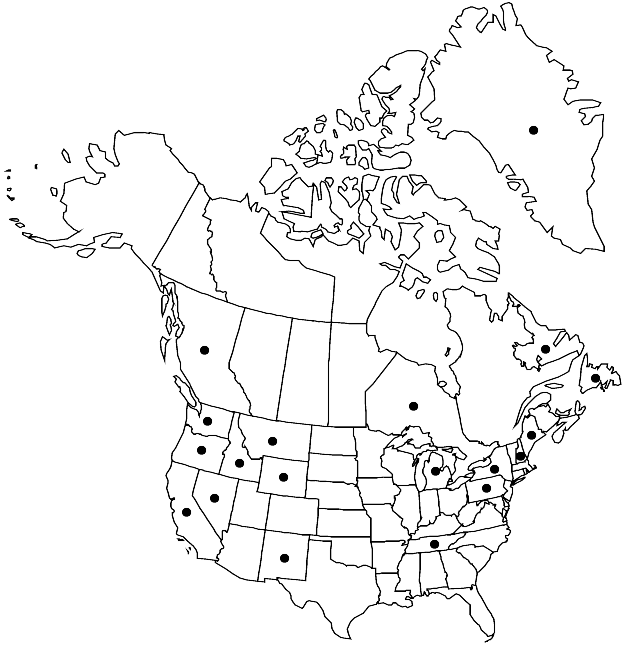Difference between revisions of "Imbribryum muehlenbeckii"
Bryologist 108: 449. 2005.
FNA>Volume Importer |
imported>Volume Importer |
||
| (6 intermediate revisions by 2 users not shown) | |||
| Line 7: | Line 7: | ||
|year=2005 | |year=2005 | ||
}} | }} | ||
| − | |basionyms={{Treatment/ID/ | + | |basionyms={{Treatment/ID/Basionym |
|name=Bryum muehlenbeckii | |name=Bryum muehlenbeckii | ||
|authority=Bruch & Schimper | |authority=Bruch & Schimper | ||
| + | |rank=species | ||
| + | |publication_title=Bryol. Europ. | ||
| + | |publication_place=4: 163. plate 381. 1846 | ||
}} | }} | ||
|synonyms= | |synonyms= | ||
| Line 26: | Line 29: | ||
|elevation=moderate to high elevations (500-3000 m) | |elevation=moderate to high elevations (500-3000 m) | ||
|distribution=Greenland;B.C.;Nfld. and Labr.;Ont.;Calif.;Idaho;Maine;Mich.;Mont.;Nev.;N.H.;N.Mex.;N.Y.;Oreg.;Pa.;Tenn.;Wash.;Wyo.;w Europe;Asia (Caucasus);Atlantic Islands (Madeira). | |distribution=Greenland;B.C.;Nfld. and Labr.;Ont.;Calif.;Idaho;Maine;Mich.;Mont.;Nev.;N.H.;N.Mex.;N.Y.;Oreg.;Pa.;Tenn.;Wash.;Wyo.;w Europe;Asia (Caucasus);Atlantic Islands (Madeira). | ||
| − | |discussion=<p>Imbribryum muehlenbeckii is similar to small forms of I. alpinum, but has strongly concave, ovate leaves, short distal laminal cells, and a weak costa. Most material from western North America can be referred to an undescribed species; see discussion under 1. I. alpinum.</p> | + | |discussion=<p><i>Imbribryum muehlenbeckii</i> is similar to small forms of <i>I. alpinum</i>, but has strongly concave, ovate leaves, short distal laminal cells, and a weak costa. Most material from western North America can be referred to an undescribed species; see discussion under 1. <i>I. alpinum</i>.</p> |
|tables= | |tables= | ||
|references= | |references= | ||
| Line 35: | Line 38: | ||
-->{{#Taxon: | -->{{#Taxon: | ||
name=Imbribryum muehlenbeckii | name=Imbribryum muehlenbeckii | ||
| − | |||
|authority=(Bruch & Schimper) N. Pedersen | |authority=(Bruch & Schimper) N. Pedersen | ||
|rank=species | |rank=species | ||
| Line 50: | Line 52: | ||
|publication year=2005 | |publication year=2005 | ||
|special status= | |special status= | ||
| − | |source xml=https:// | + | |source xml=https://bitbucket.org/aafc-mbb/fna-data-curation/src/2e0870ddd59836b60bcf96646a41e87ea5a5943a/coarse_grained_fna_xml/V28/V28_234.xml |
|genus=Imbribryum | |genus=Imbribryum | ||
|species=Imbribryum muehlenbeckii | |species=Imbribryum muehlenbeckii | ||
Latest revision as of 22:34, 5 November 2020
Plants small to medium-sized, dark red to red-green, rarely entirely green. Stems 0.5–2(–3) cm, julaceous, without metallic sheen, older stem sometimes densely radiculose. Leaves rigid, imbricate, crowded, dark red to red-green, sometimes dark green, ovate, distinctly concave, 1–2(–3) mm; base not or weakly decurrent; margins revolute proximally, plane distally, entire to finely serrulate distally, limbidium absent; apex rounded to broadly acute, not cucullate; costa reddish, not reaching apex or rarely percurrent, awn absent; basal laminal cells occasionally pigmented, in 1 row; proximal cells abruptly quadrate, with scattered short-rectangular cells, 1–2:1; medial and distal cells hexagonal, (40–)50–70 × (16–)18–24 µm, (2–)3–4:1, walls firm, parallel to costa. Specialized asexual reproduction rare, by rhizoidal tubers, on rhizoids arising from leaf axils, orange-red to red-brown, 100–200 µm. Seta ± straight, red, red-brown, or purple. Capsule nutant, dark red-brown, short-pyriform, 2–3 mm, neck short. Spores 14–18 µm, papillose, yellow-brown.
Phenology: Capsules mature Jun–Aug (summer).
Habitat: Damp shaded siliceous rock, soil in rock crevices, montane
Elevation: moderate to high elevations (500-3000 m)
Distribution

Greenland, B.C., Nfld. and Labr., Ont., Calif., Idaho, Maine, Mich., Mont., Nev., N.H., N.Mex., N.Y., Oreg., Pa., Tenn., Wash., Wyo., w Europe, Asia (Caucasus), Atlantic Islands (Madeira).
Discussion
Imbribryum muehlenbeckii is similar to small forms of I. alpinum, but has strongly concave, ovate leaves, short distal laminal cells, and a weak costa. Most material from western North America can be referred to an undescribed species; see discussion under 1. I. alpinum.
Selected References
None.